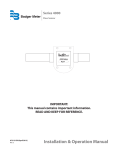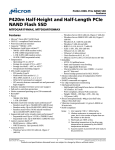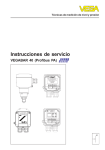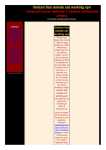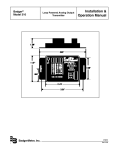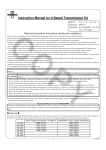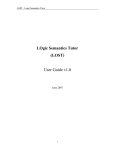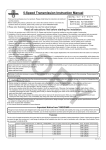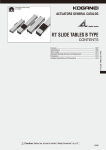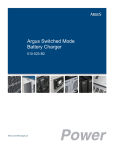Download 4000 owners manual
Transcript
Series 4000 Flow Sensors by Data Industrial Data Industrial 4000 Series FLOW Owner’s Manual Data ® Industrial 2/95 PN 72121 Table of Contents Introduction ................................................................... 1 Models ........................................................................... 1 Mechanical Installation .................................................. 3 General ................................................................... 3 For PVC Sensors .................................................... 3 For PVDF Sensors .................................................. 3 Dimensions ............................................................. 4 Electrical Installation ...................................................... 5 Impeller Assembly and Shaft Replacement ........................................................ 7 Detecting Coil and Electronic Assembly Replacement.................................................8 Replacement Part Numbers. ......................................... 9 Calibration . ................................................................. 11 Calibration Tables. ...................................................... 12 Digital Output. ....................................................... 13 Analog Output. ...................................................... 14 Specifications. ............................................................. 15 Pressure/Temperature Diagrams. ......................... 17 Troubleshooting ........................................................... 18 Warranty ...................................................................... 20 All rights reserved. No part of this work covered by the copyrights hereon may be reproduced or copied in any form or by any means - graphic, electronic, or mechanical, including photocopying, recording, taping, or information and retrieval systems - without written permission of Data Industrial. Copyright © 1995 Data Industrial Corporation 11 Industrial Drive Mattapoisett, Ma. 02739 508-758-6390 FAX: 508-758-4057 Data Industrial Series 4000 Manual Introduction Data Industrial nonmagnetic flow sensors provide an accurate measurement of liquid flow. The Series 4000 offers sensor models which cover applications for 1/2" to 1" pipe sizes and a wide range of pressure/ temperature specifications. When used in conjunction with Data Industrial Series 1000, Series 985, Series 800, Series 600, and Series 500 electronics, the measurement may be displayed or transmitted as a rate or total. The Series 4000 Sensors consist of a molded housing, rotating impeller, and externally mounted electronics housing using a proprietary, nonmagnetic sensing technology. The closed six-bladed impeller design provides higher and more constant torque then four-bladed designs, and is less prone to fouling by water borne debris, The shape of the impeller and the absence of magnetic drag provides improved operation and repeatability even at low flow rates. The housing design allows the impeller, bearings, shaft, or O-Rings to be cleaned or replaced without removing the sensor from the piping system. Two signal output options are available. One option is a 5 volt DC square wave frequency proportional to flow rate. Power for the circuit is provided by a Data Industrial flow monitor or other external source via a 3-Wire shielded cable. An internal preamplifier allows the signal to travel 2000 feet without amplification, 20 feet of 3 conductor cable is provided with this option. The second output option is a 4-20mA current analog signal. Power is provided by the two wire loop so the distance from the receiver is a function of power supply voltage and wire resistance. 30 inches of connector cable are provided with the analog version. Sensors of similar type are interchangeable, so there is no need for recalibration after servicing or replacement. Models Data Industrial provides several basic sensor configurations using the same impeller element. This allows for a wide range of applications and pipe sizes. Standard configurations use the materials listed on the next page for wetted parts in the housing and closure. Consult factory for availability of other materials. All 4000 series sensor electrical components are self-contained. They may replaced in the field without requiring recalibration or breakdown of the piping system. Pressure/temperature ratings for the various models are contained in the Specifications section of this manual. The series 4000 flow sensor models are summarized in the table on the page 3. 1 Data Industrial Series 4000 Manual Figure 1 4000 Series Model Matrix Example: 4 STYLE Standard Enhanced low flow (available in ½" and ¾" only) SIZE ½" ¾" 1" MATERIAL PVC furnished with schedule 80 tail pieces PVDF socket PVDF union threaded PVDF with unions and socket ends PVDF with 316 stainless steel FNPT union end PVDF flanges PVDF with CPVC socket union end ELECTRONICS Pulse output Pulse output with EFI foil shield 4-20mA analog output O-RING Viton EPDM Kalrez Food Grade Silicon Neoprene Chemraz Teflon Encapsulated Viton SHAFT Zirconia Ceramic Hastalloy C Tungsten Carbide Titanium Alumina Ceramic Monel 316 Stainless Steel Tantalum IMPELLER Tefzel BEARING Tefzel 2 1 1 7 10 - 0 0 2 2 0 1 0 1 2 2 3 4 5 7 8 9 00 01 10 0 1 2 3 4 5 6 0 1 2 3 4 5 6 7 2 2 Data Industrial Series 4000 Manual Mechanical Installation General The accuracy of flow measurement for all flow measuring devices is highly dependent on proper location of the sensor in the piping system. Irregular flow velocity profiles caused by valves, fittings, pipe bends, etc. can lead to inaccurate overall flow rate indications even though local velocity measurement may be accurate. A sensor located the pipe where it can be affected by air bubbles, floating debris, or sediment may not achieve full accuracy, and could be damaged. Data Industrial flow sensors are designed to operate reliably under adverse conditions, but the following recommendations should be followed to ensure maximum system accuracy: 1) Choose a location along the pipe where 10 pipe diameters of straight pipe upstream and 5 pipe diameters of straight pipe downstream of the sensor provide no flow disturbance. Pipe bends, valves, other fittings, pipe enlargements and reductions should not be present in this length of pipe. 2) The preferred orientation for horizontal flow is with the curved portion of the sensor housing down. Sensors installed with the curved portion in the up position could trap air causing inaccurate flow measurement, especially at low flows. Sensors installed with the curved portion pointing sideways may not only trap air, but increase impeller friction, which may also affect measurements at low flow rates. Locate sensor to facilitate servicing. 3) The preferred vertical location is with liquids flowing up. If vertical flow downward is the only option, the pipe must be completely filled with fluid. Any circumferential orientation is correct, but the sensor should be located to facilitate servicing. A vertical location may result in reduction of accuracy. Installation for PVC Sensors 10 diameters of straight pipe upstream and 5 diameters downstream are supplied with the PVC sensor in the form of attached Schedule 80 plain end pipe nipples. Any compatible size and type of fitting or adapter may be connected to the pipe nipples by thermal or solvent welding. Be sure the fittings and method you choose in install the PVC unit complies with American Society for Testing and Materials (ASTM) standards. Proper installation has the arrow in the stainless steel cover pointing the same direction as the flow of the fluid. Do not connect directly to reducing (or enlarging) fittings. An additional 10 diameter upstream and 5 diameter downstream allowance should be made if this is unavoidable. Installation of PVDF Sensors PVDF sensors are supplied with combination end connections. A socket sized to accept most metric sized PVDF pipe may be used for direct thermal welding. In addition, there is an external thread compatible with George Fisher PVDF union fittings for use with existing fittings. PVDF flow sensors may also be purchased with George Fischer unions that terminate in metric dimension sockets, or a wide variety of threaded or flanged connections. In PVDF sensors with the enhanced flow feature, the flow enhancement jet must be inserted before installing the sensor into the system. With the stainless steel cover facing you, insert the jet into the left socket (upstream end) and then perform the method chosen for installation. Proper sensor orientation is with the arrow on the stainless steel cover pointing in the same direction as the flow of the liquid. The same 10 and 5 diameter upstream and downstream allowance and orientation recommendations, as described under Installation for PVC sensors above, must be followed. 3 Data Industrial Series 4000 Manual Figure 2 Dimensions 2.16 (55mm) 2.16 (55mm) 3.50 (89mm) 3.50 (89mm) A B 2.69 (68mm) Data Industrial 4000 Series A B 2.69 (68mm) 3.59 (91mm) Data Industrial C FLOW Dimensions Model A B ½" 8.83"/224mm 4.08"/104mm ¾" 10.69"/272mm 4.69"/119mm 1" 13.15"/334mm 5.40"/137mm PVC 4 4000 Series 3.59 (91mm) FLOW Dimensions Model A ½" 5.58"/142mm ¾" 6.12"/155mm 1" 6.68"/170mm B 3.54"/90mm 3.92"/100mm 4.32"/110mm PVDF C 1.85"/47mm 2.24"/57mm 2.52"/64mm Data Industrial Series 4000 Manual Electrical Installation The Series 4000 digital transmitter is supplied with 20 feet of 20 AWG, 3 conductor cable with drain wire and shield. The Series 4000 analog unit is supplied with 30" of cable. Make electrical wiring connections according to accepted trade practices. An electrical junction box may be attached directly to the sensor electronic module, or mounted in the vicinity of the sensor. Locate it conveniently to facilitate replacement of the electronic module assembly. The wiring connections should not be subjected to water of conductive liquids, as these may impair operations or damage the sensor circuitry. When the connecting to the electronic device, observe the wire colors and polarity to insure proper performance and to prevent damage to the sensor or electronic device. ELECTRICAL WIRING-DIGITAL UNIT Below is the general wiring instructions for the digital output unit. If you are connecting to a Data Industrial flow monitor consult the appropriate owners manual. 1) Connect the Red sensor wire to the positive (+) wire or terminal. 2) Connect the Black sensor wire to the negative (-) wire or terminal. 3) Connect the White sensor wire to the signal (S) wire or terminal. 4) Connect the Bare sensor wire to sensor shield. 5) Electrical installation complete. ELECTRICAL WIRING-ANALOG UNIT 4-20mA power must be off and all wiring should be done before turning on loop power. 1) Refer to Figure 3 on next page for illustration of the following instructions. 2) Wire the Red Wire (+ Analog loop) of the flow sensor to the POSITIVE (+) output of a DC power supply. 3) Wire the Black Wire (- Analog Loop) of the flow sensor to the POSITIVE (+) input of your analog device. 4) Wire the NEGATIVE (-) input of your analog device to the NEGATIVE (-) of the DC power supply. 5) Electrical installation complete. 5 Data Industrial Series 4000 Manual Figure 3 Analog Wiring for 4000ANL NOTE: There are two additional wires in the sensor cable (brown and orange). These wires are for factory calibration only, connecting to these wires may damage unit and void warranty. 6 Data Industrial Series 4000 Manual Impeller Assembly and Shaft Replacement The following tools are required for the replacement of the impeller and shaft: 5/32 “ Allen wrench, flat blade screwdriver, torque driver in “in-lb” with 5/32 “male hex adapter. Units are factory calibrated @ 12in-lbs. 1) Depressurize the pipe on which the sensor is to be serviced. WARNING: DO NOT REMOVE SOCKET HEAD CAP SCREWS WHILE SYSTEM IS UNDER PRESSURE. 2) Using the Allen wrench, loosen and remove the four #10 socket head cap screws along with the stainless steel cover. It is not necessary to remove the electronics to service the impeller and shaft. 3) Utilizing the provided slots alternately, pry the Impeller Cover/Shaft Assembly from the sensor housing with the flat blade screwdriver. 4) Inspect the impeller and impeller cover/shaft assembly for signs of wear. Replace if necessary. It is good practice to replace O-rings before reassembling. Use no lubricants on O-rings. (See page 9 for replacement part numbers.) 5) To reassemble the sensor, position the impeller into the cavity of the sensor housing, making sure the six blades are pointing into the flow direction. The unit will not operate if the impeller is positioned incorrectly. EXAMPLE: If flow direction is to the right, position impeller with blades pointing to the left. (See Figure 1 below) 6) Orienting the keyway of the impeller cover/shaft assembly to the small slot between the two large slots and aligning the shaft to the shaft hold of the impeller, hand press the impeller cover/shaft assembly into the sensor housing cavity. 7) Fasten the stainless steel over to the sensor housing using the #10 socket head cap screws. Torque the #10 hardware to 12 in-lb. pressurize system. WARNING: ALL FOUR SCREWS MUST BE IN PLACE AND TORQUED CORRECTLY BEFORE PRESSURING SYSTEM! Figure 4 Flow Direction PVC VERSION IMPELLER IMPELLER COVER/SHAFT ASSEMBLY STAINLESS STEEL COVER #10 HARDWARE 7 Data Industrial Series 4000 Manual Detecting Coil and Electronic Assembly Replacement A #1 Phillips screwdriver is required for servicing electronics. It is not necessary to depressurize or drain the system to service the electronics. 1) Disconnect sensor wiring from display or transmitter 2) Using a Phillips screwdriver, loosen and remove the two #4 Phillips head screws and accompanying hardware. CAUTION: LETTING ELECTRONIC ASSEMBLY DROP FROM SENSOR COULD DAMAGE DETECTING COIL. 3) Unplug coil from electronics NOTE: ON ANALOG UNITS THE COIL IS PERMANENTLY ATTACHED TO ELECTRONICS 4) Plug coil to replacement electronics and reattach the electronics to the sensor with the two #4 Phillips screws. CAUTION: BE SURE WIRES FROM COIL ARE TUCKED IN BEFORE TIGHTENING SCREWS. (See next page for replacement part numbers) 5) To replace Detecting Coil, first remove the Electronic assembly per Step 1. Unplug coil from electronics. Remove the two #6 Phillips head screws, the coil retaining plate and secure to sensor housing with the #6 hardware. Plug replacement coil to Electronic Assembly and fasten the electronics to the sensor with the hardware (See the next page for replacement part numbers.) The coil wire orientation is not critical to the operation. Figure 5 COIL IMPELLER BODY COIL RETAINING PLATE #6 HARDWARE ELECTRONIC ASSEMBLY #4 HARDWARE 8 Data Industrial Series 4000 Manual Replacement Part Numbers Impeller Coil Kit (For Digital Output Unit Only) Contains (1) coil, (1) retaining plate, (2) #6 screws O-Ring Kit PVDF units only for use with Unions O-Ring Kit, 1/2" for 20mm Union O-Ring Kit, 3/4" for 25mm Union O-Ring Kit, 1" for 32mm Union 08010 711333 40030K 40130K 40230K Union Kit 1/2" (20mm) PVDF (2) PVDF Union Ends, 20mm (2) PVDF Union Nuts, 20mm (2) Viton O-Rings 711380 Union Kit 3/4" (25mm) PVDF (2) PVDF Union Ends, 25mm (2) PVDF Union Nuts, 25mm (2) Viton O-Rings 711381 Union Kit 1" (32mm) PVDF (2) PVDF Union Ends, 32mm (2) PVDF Union Nuts, 32mm (2) Viton O-Rings 711382 9 Data Industrial Series 4000 Manual Figure 6 4000 Impeller Repair Kit Matrix Example: 400 2RK COVER MATERIAL PVC PVDF COVER O-RING Viton EPDM Calrez Food Grade Silicon Neoprene Chemraz Teflon Encapsulated Viton SHAFT Zirconia Ceramic Hastalloy C Tungsten Carbide Titanium Alumina Ceramic Monel 316 Stainless Steel Tantalum IMPELLER Tefzel BEARING Tefzel - 0 2 0 1 2 3 4 5 6 0 1 2 3 4 5 6 7 2 2 Example: 4000EK 10 2 2RK 3RK Figure 7 4000 Electronic Repair Kit Matrix ELECTRONICS Pulse output Pulse output with foil shield 4-20mA analog output 0 - 10 00 01 10 Data Industrial Series 4000 Manual Calibration If you are replacing an existing Data Industrial 4000 Series sensor and have already calibrated your flow monitor, no calibration changes are necessary. For Installation of a new flow monitor, please refer to the calibration instructions in the flow monitor manual. The Data Industrial Series 4000 flow sensor, like all impeller or turbine flow meters, operates by converting kinetic energy (in the flow stream) into rotation (of an impeller). Indeed, almost all flow sensors work on the principle of converting flow energy to output signal. The only arguable exceptions are ultrasonic and electromagnetic sensors. The interaction of the flow stream and the impeller depend, to a currently unquantified extent, on fluid properties (density, viscosity, and pressure) and on physical properties of the impeller. The Data Industrial impeller design features the following: 1) a low mass polar moment of inertia 2) no magnetic drag 3) very low eddy current drag 4) low bearing friction The impeller housing forms the periphery of a rotating fluid stream, the only source of drag tending to retard the impeller. The efficiency of this design is the key to the repeatability of sensor output at very low flow rates, and is the reason that the pressure drop across the installed sensor is so low. Series 4000 flow sensors have been calibrated on the Data Industrial flow bench, shown schematically on TD4000CAL. The calibrating fluid is untreated tap water, at ambient temperature, and at various pressures. All calibration tests are based on average flow rate and average frequency measured during the delivery of 200 pounds of water over the time period required to deliver that weight of water at a given flow rate. Our flow bench and calibration practice conform to ASME/ANSI MFC-9M-1988, Measurement of Liquid Flow in Closed Conduits by Weighing Method. Sensors are calibrated based on the average flow rate. Flow velocity in feet per second is calculated therefrom based on the theoretical pipe diameters. Data accuracy, as noted on TD4000CAL, is estimated to be the following for each individual test of sensor/flow rate combination: +/-0.15% on average flow rate (q) +/-0.10% on average frequency (f) Tests on at least 12 points across the rated flow range of the specific sensor, including at least one slightly above maximum rated flow, and at least one slightly below minimum, were performed on at least six different samples of each of the basic design. Output data points (72 minimum) for each basic model were analyzed using standard regression techniques, to find the best linear least squares fit describing flow rate (q) as a function of frequency (f) in the form: q=kf+b(EQ1) The values of k and b are developed to produce the minimum summed squared differences between the actual flow rate at an observed frequency and the flow rate predicted by EQ1 at that observed frequency. The results of this analysis indicate that the calibration constants given below are accurate within +/- 1% of full scale given the following constraints: 1) constant pressure 2) constant temperature 3) water as the fluid medium This 1% covers the effects of non linearity in the flow rate/frequency relationship and dimensional variations from sensor to sensor. 11 Data Industrial Series 4000 Manual Testing to date indicates that over a relatively broad range of operating pressure and temperature, factory calibration should be adequate to yield results accurate within +/-1% of full scale in fluids not markedly different in density and viscosity from water. Repeatability with most compatible fluids at constant pressure and temperature should be within 0.7% or less, although the actual readings may be significantly in error if the viscosity and density of the sensed fluid depart drastically from water. PVC sensor calibration is based on flow through standard Schedule 80 PVC pipe. The effects on calibration of joining the standard Schedule 80 pipe terminations in a system of other than PVC Schedule 80 have not been investigated. We caution you to anticipate some deviation in calibration. This effect can be minimized if an additional 10 to 20 diameter lengths of PVC Schedule 80 pipe of the appropriated diameter is installed upstream of the sensor, and a similar 5 to 10 diameter lengths downstream. PVDF sensor calibration is based on flow through industry standard PVDF pipe. Similar action should be taken if the PVDF sensor is used in a system based on other piping technologies. Calibration Table-Digital Output The following table provides calibration and operational data for the various models of the Series 4000 sensor. The data is organized as follows: Column 1: Model number, to which the data listed in the particular column pertains Column 2: Housing material Column 3: Nominal pipe size Column 4: Pipe O.D., per applicable standards Column 5: Pipe I.D., per applicable standards Column 6: Slope of the regression line used in calibration (k) Column 7: Intercept of the regression line (Offset) Column 8: Minimum recommended flow rate (GPM) Column 9: Maximum recommended flow rate (GPM) Column 10: Pulse rate at minimum flow (Hz) Column 11: Pulse rate at maximum flow (Hz) Column 12&13: Calibration identification number used to calibrate the Data Industrial Series 1000 flow monitors The calibration constants in Columns 6 and 7 relate frequency (Hz) to flow rate (GPM) in the equations: FREQ= GPM K -Offset GPM = K (FREQ + Offset) 12 Data Industrial Series 4000 Manual Calibration Table Sensor # Mat'l Pipe ID k Offset GPM GPM min max 400200 PVC 1/2 #80 .0840 in 0.546 0.413 0.3496 0.73 14.60 1.417 34.992 .50 12.7 401200 PVC 3/4 #80 1.050 in 0.824 0.5735 0.2638 1.66 33.24 2.639 57.799 .75 19.0 402000 PVC 1.315 in 0.957 0.6134 0.1826 2.24 44.84 3.472 72.914 1.00 25.4 410200 PVC 1/2 #80 .0840 in 0.546 0.1421 0.8474 0.18 5.84 0.437 40.243 .51 12.9 411200 PVC 3/4 #80 1.050 in 0.824 0.3287 0.2159 0.42 13.30 1.048 40.237 .76 19.3 400300 400400 400500 401300 401400 401500 402300 402400 402500 410300 410400 410500 411300 411400 411500 Nom. Pipe 1 #80 Pipe OD Hz min Hz max Model Model 1000 1000L ID ID PVDF 1/2" 20mm 16.2mm 0.5987 (0.787in) (0.638in) 0.0008 1.00 19.93 1.664 33.287 .55 13.9 PVDF 3/4" 25mm 21.2mm 0.613 (0.984in) (0.835in) 0.02664 1.71 34.14 2.518 55.418 .73 18.5 PVDF 1" 32mm 27.2mm 0.6266 (1.260in) (1.071in) 0.0314 2.81 56.16 4.450 89.589 1.02 25.9 PVDF 1/2" 20mm 16.2mm 0.1445 (0.787in) (0.638in) 0.4841 0.25 7.97 1.240 54.688 .56 14.2 PVDF 3/4" 25mm 21.2mm 0.3195 (0.984in) (0.835in) 0.4679 0.43 13.65 0.868 42.270 .74 18.7 13 Data Industrial Series 4000 Manual Calibration Table-Analog Output Analog versions of the Series 4000 are precalibrated at the factory using the flow ranges tabulated below. Sensor # Mat'l Pipe ID 4mA Flow 20mA Flow 400210 PVC 1/2 #80 .0840 in 0.546 0 20 401210 PVC 3/4 #80 1.050 in 0.824 0 30 402010 PVC 1.315 in 0.957 0 40 410210 PVC 1/2 #80 .0840 in 0.546 0 8 411210 PVC 3/4 #80 1.050 in 0.824 0 12 20mm 16.2mm (0.787in) (0.638in) 0 20 25mm 21.2mm (0.984in) (0.835in) 0 30 32mm 27.2mm (1.260in) (1.071in) 0 40 20mm 16.2mm (0.787in) (0.638in) 0 8 25mm 21.2mm (0.984in) (0.835in) 0 12 400310 400410 400510 401310 401410 401510 402310 402410 402510 410310 410410 410510 411310 411410 411510 14 PVDF PVDF PVDF PVDF PVDF Nom. Pipe 1 #80 1/2" 3/4" 1" 1/2" 3/4" Pipe OD Data Industrial Series 4000 Manual Specifications Wetted Materials SENSOR HOUSING AND ENHANCING JET (If Applicable) PVC - Virgin polyvinyl chloride, Type 1, Grade 1 PVDF - Virgin polyvinylidene fluoride O-RINGS Viton® - registered trademark of E.I. du Pont Nemours Company EPDM Kalrez® - registered trademark of E.I. du Pont Nemours Company Silicon - Food Grade Neoprene Chemraz® - registered trademark of Greene Tweed Company Teflon Encapsulated Viton IMPELLER SHAFTS Zirconia Ceramic Hastelloy - C-276 Tungsten Carbide - GE Carboloy 883 colbalt binder Titanium - Titanium Alloy 86Ti-6AL-6V-25A Alumina Ceramic - Diamonite Grade P3142-1 Monel - Grade K500 Stainless Steel - 316 Stainless Steel Tantalum - Commercial Grade PROCESS CONNECTIONS PVC (Virgin polyvinyl chloride, Type 1, Grade 1) schedule 80 tail pieces PVDF (Virgin polyvinylidene fluoride) sockets PVDF union thread (For joining existing piping systems with GF unions) PVDF union nuts with socket union ends PVDF union nuts with 316 stainless steel FNPT union ends PVDF flanges PVDF union nuts with CPVC socket union ends IMPELLER AND BEARING Tefzel® - registered trademark of E.I. du Pont Nemours Company Pressure, Temperature Ratings • Depends on hardware configurations. See Diagram at end of this section. Operating Flow Range • 0 to 30 ft/sec for standard range units • 0 to 10 ft/sec for enhanced flow range units Recommended Design Flow Range • 1 to 20 ft/sec for standard range units to maintain calibration accuracy • 0.25 to 8 ft/sec for enhanced flow range units to maintain calibration accuracy 15 Data Industrial Series 4000 Manual Accuracy • +/- 1.0% of full scale over recommended design flow range with water @50-80 F and 20-40 psig Repeatability • +/- .7% of full scale over recommended design flow range Linearity • +/- .7% of full scale over recommended design flow range • +/- 1.0% frequency to current conversion Transducer Power Digital Output Unit • Typically provided by Data Industrial flow monitor or transmitter. Any alternate supply must be of a resistance-limited type meeting the following constraints: • Supply Voltage: 9 to 20 VDC • Supply Current: 2mA maximum Analog Output Unit • 10 VDC minium to 35 VDC maximum. The combination of loop supply voltage and total loop series resistance must insure that the device voltage remains within these limits over the 4-20mA output span. Output Digital Output Unit • Pulse: square wave (approximately) output @ 1 pulse/revolution • Voltage: • 0.4 V maximum (output low) • 45 V Minimum (output high) Into high impedance load Output is 5 volt CMOS and LSTTL compatible. The output can be forced to any logic level up to 20 volts by an external pull-up resistor. • Sink Current: 2mA maximum Analog Output Unit • 16 Signal: Loop Powered 4-20mA current analog with offset compensation output for ripple less then 0.25% of full scale. Data Industrial Series 4000 Manual Pressure Temperature Diagram for Series 4000 Sensors 400 350 300 275 250 Pressure (psi) 200 150 100 PVC PVDF 50 0 50 100 140 150 220 200 250 17 Data Industrial Series 4000 Manual TROUBLESHOOTING GENERAL Primary consideration for troubleshooting a Series 4000 flow sensor is to first establish that the problem lies with the sensor and not with the electronic device connected to it. A simple way to help determine this is to substitute a known working sensor for the suspect unit. If the electronics react in an appropriate manner, you may conclude that the problem is sensor related. Another option would be to provide a similar, square wave pulse simulation by hooking up a frequency generator to the interface electronics and simulating as close as possible the actual sensor signal. If you suspect a sensor problem, there are a few mechanical considerations to be addressed: 1) Make sure there is flow in the pipe line appropriate to the operations range (0.25-20 feet/second) of the sensor. 2) Make sure that the wiring between the sensor and the electronics is correct. If a junction box has been added, also make sure that all wiring connections are right. 3) Check the impeller assembly to make sure it is not mounted in the reverse direction of flow. 4) Make sure that impeller can spin freely on the shaft and that no foreign matter of debris has lodged in the sensor housing. TROUBLESHOOTING THE SENSOR Digital Circuit A sensor is a powered device, required voltage between 8VDC and 20 VDC, applied between the RED (+) and BLACK (-) sensor leads. The sensor will normally draw about 1 mA for this supply. WARNING: DO NOT EXCEED 20 VDC; SENSOR DAMAGE MAY RESULT. 1) The white sensor wire should be disconnected. Make sure that the Black, Red and Shield wires remain connected to the proper terminals. 2) Install a voltmeter, Positive (+) to the white sensor wire and Negative (-) to the black sensor wire. If flow exists, you should see a square wave switching between 0.0 VDC (low) and 4.0 VDC (high). NOTE: The pulse may be too fast for the voltmeter to recognize as a square wave, but it may appear as an unstable reading somewhere between 2.0 and 4.9 VDC. If low is stopped, the output will hold in either a high (4.0 VDC) state or low (0.0 VDC) state, depending on the position of the impeller reflector or other factors. To simulate impeller rotation, simply pass a metal object (i.e. large screwdriver or pliers) past the back of the sensor. The output signal should then switch states. 3) If the sensor produces pulses in the above tests, reconnect the white sensor wire to the signal input terminal of the transmitter (Model 1000, 500, 800, etc.) With the voltmeter still connected, note the actual voltage levels between the output switching (such as 0.0 VDC low or 4.0 VDC high). If reconnecting the sensor to the transmitter either stops or significantly alters the voltage levels of the pulses, or if the transmitter does not respond to the pulses, consult the factory or your local representative. 18 Data Industrial Series 4000 Manual 4) A nonworking sensor could be the result of either a sensing coil failure or a component failure in the electronic module (blue cover). Using an Ohm meter, determine the coil resistance by removing the blue electronics cover containing the encapsulated circuitry. Unplug the coil from the electronics in the cover. Connect the probes of the Ohm meter to the wire terminals of the coil plug-in connector. The coil resistance should measure between 5 and 10 ohms. A very low or very high resistance reading may indicate failed coil; if this appears, replace the coil. 5) If the coil appears to be within specification, replace the blue cover assembly from another working device. If the sensor begins working, replace the electronic assembly. 6) If the sensor switches states when a metal object is passed near the back of the sensor, but no pulse occurs when flow exists, verify that the flow meets our minimum flow requirements for the sensor. Check further the condition of the impeller and the shaft for mechanical wear or damage. If replacement is necessary, a repair kit is available containing the appropriate components. 7) If the sensor was working and a rebuild kit was installed due to a failure of the impeller or shaft and the sensor did not return to working order, check to ensure that the impeller was installed in the proper direction. If the impeller was installed backwards to the flow direction, no signal pulse will be generated even if the impeller spins freely. 8) Should you experience any other difficulties with the sensor, please consult the factory or you local representative. Please have a description of the problem, model, serial number, and application information available when you call. Analog Circuit 1) Connect Power supply and ammeter in a series loop 2) With no flow in the pipe check to see if the output is reading 4mA. If the output is greater or less than 4mA then the analog electronics assembly must be recalibrated at factory. 3) With flow in the pipe the output should be something higher then 4mA but not greater then 20mA. If you cannot get flow through the system you can simulate flow two ways. The first way is to blow into one side of the unit to make impeller spin and the other is to pass a metal object (nut driver, wrench, etc...) across the back of the electronics housing. Either one of the last two methods will excite the analog output to change and read greater then 4mA. 4) If the analog output does not change with any of the actions done in step three then the electronics assembly is defective. ` 5) If the analog changes when you pass a metal object across the rear of the electronics assembly but does not at any other time then inspect the impeller assembly. 19 Data Industrial Series 4000 Manual 20 Data Industrial Series 4000 Manual Warranty Data Industrial Corporation (“Seller”) of 11 Industrial Drive, Mattapoisett, Massachusetts 02739-0740, U.S.A., warrants to the original purchaser of its product that such product manufactured by Data Industrial Corporation shall be free from defects in materials or workmanship when installed, serviced and operated according to Data Industrial corporation instructions or in other such normal use. This warranty is effective for a period of 12 months from the date of installation by the Purchaser or 18 months from the date of shipment by the “Seller” whichever occurs or terminates first. This limited warranty does not cover damage or loss resulting from corrosion or erosion caused by acids or other chemicals or by severe environmental conditions or negligent or improper installation or improper operation, misuse, accident, unauthorized repair or substitution of components other than those provided by the “Seller”, and does not cover limited life components such as bearings, shafts, impellers where wear rate is a function of application and environment. Any component not manufactured by the “Seller” but included in its products shall not be covered by this warranty and is sold only under such warranty as the manufacturer may provide. If Buyer or Purchaser wishes to make a claim hereunder, he shall send written notice of any defect within the warranty period, to “Seller” at the above address. “Seller” may at its sole option instruct Buyer to ship subject part, postage prepaid, to the “Seller” at above address or authorize a representative to inspect the part on site. “Seller” will at its sole option repair or replace any defective product covered by this warranty. If Buyer makes repairs or alterations to any product or part covered by this warranty without “Sellers” prior written approval, this warranty shall be null and void. The foregoing shall constitute Buyers or Purchasers sole and exclusive remedy against “Seller”, and no other remedy, including but not limited to, incidental or consequential damages for personal injury, loss of fluids, gases or other substances or for loss of profits or injury to property or person shall be available to the Buyer or Purchaser. The warranty extended herein shall be in lieu of any other implied warranty of merchantability or fitness for a particular purpose, and seller shall bear no liability for representatives or retail sellers. In no event shall Data Industrial Corporation be liable for any contingent, incidental, or consequential damage or expenses due to partial or complete inoperability of its product. 21 20























